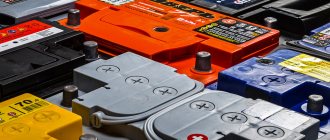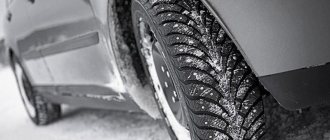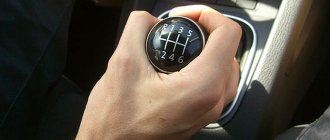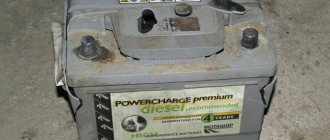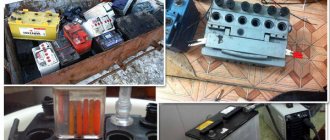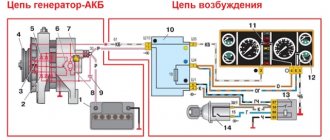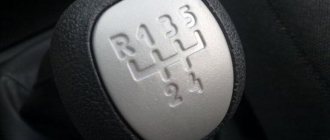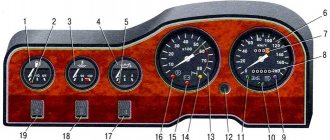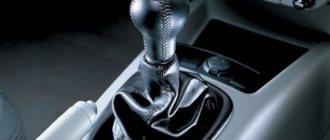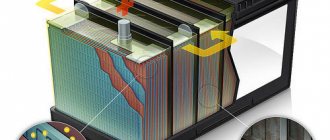Safety precautions
For a beginner who is removing the battery from a car for the first time, it is unclear which terminal is removed first from the battery.
It is important for him to build the entire chain of actions step by step: what to do first, and what to do next. There is nothing complicated in this procedure if you strictly follow safety precautions and sequence of actions. To remove the battery, you need to use a wrench and a rag. The battery must not be pushed or turned over, as particles settled at the bottom of the battery can fall on the surface of the plates, which will lead to a short circuit and failure of the device.
The electrolyte contained in the battery should never come into contact with the skin. But if this happens, you need to wet your hand in an alkaline deactivator.
Self-discharge and leakage currents
When a rechargeable lithium battery is used as a storage component for indoor energy harvesting, the battery leakage current cannot be ignored, especially in ultra-low power applications. It is generally believed that the leakage current in a lithium battery is in the small µA range.
An experimental method for measuring it is proposed by applying a µA charge to a stabilized battery with post-charging to observe the change in voltage at the terminals. When the applied charging current is greater than the leakage current, a positive sign (increase in terminal voltage) may be observed. Otherwise – negative. By gradually changing the charging current, using a search algorithm in successive approximation, the leakage current will finally converge with the applied charging current.
Convergence occurs after changing sign in two successive search procedures, demonstrating that charging currents approach the leakage current in both directions. The approximation accuracy can be improved by adjusting the number of sign changes in the successive approximation search algorithm. The proposed method allows the full capacity of a rechargeable lithium battery to be used with ultra-low power consumption.
Battery removal procedure
It is important to remember how to properly remove the terminals from the battery. There is a certain order of actions that must be followed. At the same time, do not forget about safety precautions. The sequence of actions is as follows:
- First you need to turn off the car.
- Turn off all electronic devices.
- Close windows and doors: if the car has power windows, after removing the battery, the windows will not be able to be raised. The doors will have to be closed manually with a key.
- Remove the cover protecting the battery terminals from dust and dirt.
- If there is no cover, you need to insulate the positive terminal with electrical tape.
- Remove grounding, if present.
- Loosen the nuts with a wrench.
- Disconnect the negative terminal, then the positive one.
- Do not allow the positive terminal to come into contact with metal objects.
An important technical point: it is the negative that needs to be disconnected first, so that a short circuit does not occur.
The car body, also called the ground, is connected to the negative terminal. When it is removed, the circuit is broken and a short circuit cannot occur, since the battery is disconnected from the body.
We recommend: Getting started with a new car battery
Thus, removing the terminal from the battery is easy. You just need to strictly follow the sequence of actions .
Next, you should take the necessary actions: recharge the battery or replace it with a new one.
Avoiding short circuits
However, it is believed that you should always disconnect the positive terminal of the battery first to prevent electricity from leaking from the battery. Let's consider a case from life. This is the story of what happened to a professional dentist who sometimes likes to fix his sports car himself. He decided to remove the battery from the car using a socket wrench to loosen its clamps. The key came into contact with the man's wedding ring, and the ring, in turn, touched the battery clamp. A massive short welded the ring to the clamp and wrench, which in turn was welded to the positive terminal.
Car batteries store enormous amounts of energy and are optimized to deliver it in a very short period of time. A shorted battery can easily produce several hundred amps—more than an arc welder. Within a second, the wedding ring became almost red-hot, and only the quick reaction of his other hand to break the connection by pressing the wrench prevented the ring from starting to melt right on his finger. The jewelry was cut from the finger in the emergency room and it took more than a month before the hapless motorist was sure he wouldn't lose his finger.
Result:
- When working with tools, remove all jewelry.
- Always disconnect the battery ground clamp before loosening the positive one. If you remove the negative and inadvertently complete a ground fault, no current will flow because the terminal is already grounded. Subsequently shorting the positive terminal to ground will not cause current to flow, since the current has no path back to the negative terminal.
- Connect the ground last.
Connecting the battery to the car
Immediately before installing the battery, it is necessary to clean the terminals with a brush. If dirt has formed on the surface of the battery, it must be removed with distilled water. Plain water cannot be used, as it may cause plaque to form.
Connect the battery in strictly reverse order:
- Place the battery in its original place.
- Tighten the fastener.
- Attach the “plus” terminal.
- Tighten the nuts with a wrench so that the structure fits tightly to the battery.
- Only after this connect the minus.
- Which terminal to remove first is “minus”. When connecting the battery back, connect the “plus” first.
What does an error in the sequence lead to?
If installation is carried out in a different order and precautions are taken, there is theoretically no danger. However, if you first install the negative terminal and secure it, then during installation you short-circuit the positive terminal to the car body with a key or other metal object, a terrible short circuit will occur. A huge current will flow. This can lead to:
- to destruction of the integrity of the battery;
- to battery failure, destruction of plates;
- to thermal and chemical burns of the skin;
- to damage to the organs of vision;
- to a malfunction of the vehicle's electrical equipment.
The cost of an error in not following the battery connection sequence is high. It is necessary to strictly adhere to the established rules.
Electronics setup
After the battery is connected, you need to adjust the on-board electronics, since after removing the battery all the settings were lost. For most cars the sequence of actions is as follows:
- Start the engine and warm it up.
- Turn off the car.
- Remove the negative terminal and wait two minutes.
- Put it back.
- Do the same with the positive terminal.
- Start the car again and let it idle for 15 minutes.
- Turn off the ignition, all data will be saved.
- Restart the car and test all electronic systems.
- Turn off the ignition and wait until the system records all parameters.
As a result, all on-board settings will be restored . This sequence of actions is suitable for all machines, regardless of brand.
Thus, in the process of installing and removing the battery, the main thing is not to confuse the sequence of actions, then a short circuit will not occur. If you learn how to restore the on-board settings of a car, you will master the full control of a modern car.
Is it possible to disconnect one terminal when storing the battery?
When parking the car for a long time, which does not involve completely removing the battery, it is recommended to disconnect both terminals of the battery. If you leave them in the electrical circuit, the battery will discharge due to operating energy consumers (alarms, individual sensors, radars, etc.). It is not recommended to remove only one terminal due to the following reasons.
- If you leave the negative terminal connected, leakage currents will remain in the electrical network, and the battery will discharge faster.
- If you leave the positive terminal connected, a short circuit may occur, which can result in damage to wiring and devices and even fire in the car.
Which terminal to put on first?
Safety regulations require that a strictly defined sequence be observed not only when removing terminals, but also when installing them. If you follow logic, it becomes clear that you should act in the reverse order. Therefore, if disconnecting the battery must be started from the minus, then it is logical to start connecting it from the plus. So, which terminal should we put on the battery first? Of course, the positive one, that is, the positive contact is connected first.
Remove the terminal to clear the error
When removing the terminal, another error may occur, which will create even more problems. There are safer ways to reset without further hassle. You can remove one terminal (plus) to cause a short circuit. If the battery is new, most likely nothing will happen. But this method is still not recommended, since in the event of a breakdown there will be nothing to reset.
If it is possible to discharge the battery to zero, it is better to do so, and then sort it out at a service center.
Special situations
If the vehicle has an on-board computer, then after removing the battery, all stored data will be deleted. In this regard, you need to double-check whether this is the case when dismantling is impossible.
Also, many drivers install third-party security systems (alarms) and wonder whether removing the battery will harm their operation. Problems occur extremely rarely and usually involve a failure of part of the system functions.
The situation is similar with radio tape recorders. Many models ask for a PIN code upon startup. If there is one, you need to find out in advance, or disable the code request first. As for the FM radio, you will have to set the frequencies again.
Removing the battery from a car is not as difficult as it seems, and it does not require any special skills. It is only important to prepare all the tools and know the sequence of the process. Work should be carried out carefully. The least of the troubles that will happen if handled carelessly is resetting the audio system. If you have no experience and it seems like you can’t handle it, it’s better to entrust the job to a specialist, especially when it comes to an expensive car stuffed with electronics.
Possible problems when removing the battery
When removing the battery, the owner runs the risk of encountering some problems. Their specifics depend on the equipment of the machine. For example, there are nuances for cars with a radio, alarm and on-board computer.
Signaling
For some car alarm models, power failure is associated with theft, so an alarm may sound. In addition, such alarms can block the doors at any time. Therefore, before removing the battery, the autonomous power supply of the alarm must be turned off. This is done with special keys that come with the alarm system.
You should first make sure that the car keys are in your pocket and not inserted into the ignition. It is better to leave one of the doors open, since when the battery is removed, the information from the alarm key fob may be erased.
Important! After returning the battery to its usual place, you need to check the alarm. After all, during the removal process, the settings that are responsible for the automatic activation or sensitivity of the alarm could have gone wrong.
Radio/cassette player
Most radios do not have their own power source, and when the battery is disconnected, the settings are most often lost. Therefore, after returning the battery to its place, you will have to re-tune the radio stations.
Important! Modern radios require a PIN code after switching on (a function that allows you to protect the device from theft). Therefore, before removing the battery, the owner should make sure that he knows the PIN code for his radio.
